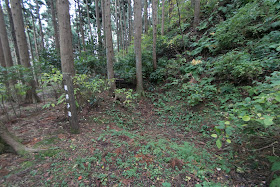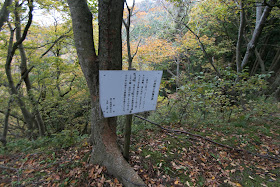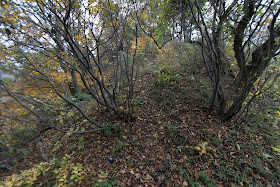Kurotaki Castle
-Irreconciable conflict after god of war (14) post-war process and afterward-
Overview
Name: Kurotaki castle (Kurotaki-jo)
Alias:
Place: Fumoto Yahiko village, Niigata
Location: 37.678064910635044, 138.81170188911662
Type: Mountain Castle
Built: 16th century
Remaining remnants: Clay walls and dry moats
Title:
30 minutes drive from Hokuriku Jidoshad Expressway Sanjo-Tsubame interchange to parking space behind central area.
Kamo Castle -Irreconciable conflict after god of war (13) mopping-up operations-
Type: Mountain Castle
Built: 16th century
Remaining remnants: Clay walls and dry moats
Title:
Brief History
Kurotaki castle (黒滝城) is located over Shiroyama mountain, one of about 230 meter height from hillside at 3 kilometer south of Yahiko-yama mountain in the line of Yahiko mountains. Yahiko-yama mountain is a prominent on independently stands at the flat land of Niigata basin, thus worshiped as the main god of Yahiko Shrine which is a traditional one referred in the ancient poem book “Manyo-Shu”.
Hokurikudo Road, an ancient and medieval road starts from Kyoto city toward current Niigata city area went up along the coast line of Joetsu region the crossed Yahiko mountains by Sarugababa-Toge pass to the east side of Yahiko mountains to avoid narrow coast area and visit the Shrine town. Castle site is at the south of the pass and suitable place to control the traffic of the pass.
In medieval era, before land reclamation and river improvement, most part of Niigata basin was a huge inner sea, and Yahiko area was peninsular prolonged into the sea. North part of Echigo province (Niigata prefecture) such as Murakami area or Shibata area was half separated from middle part of the province by this inner sea, and local lords of north part called as “Agekita-Shu” also kept semi-independent status.
For Uesugi clan which was the governor of province resided at Joetsu area at the southwest edge of the province, Yahiko area was an advance position to watch the local lords of Nagaoka area and north part opposite of inner sea, and in case of need suppress them by placing army. Furthermore, Teradomari port at the south of castle site was a port to Sado island.
Origin of Kurotaki castle
The origin of Kurotaki castle is not clear. At the north of Yahiko-yama mountain there was local lord Oguni clan at Tenjinyama castle (Niigata prefecture), and three castles around this area it mean Tenjinyama castle, Kurotaki castle and Kikyo castle have same structure utilizing two ridges as defense line and use the valley between ridges as terrace. There might some connection among three castles.
In 1507, Tamekage Nagao (1486-1583), the deputy governor of Echigo province, rebelled against the governor Fusayoshi Uesugi (1474-1507), and killed Fusayoshi on the escape to Kanto region. But three years later, Akisada Uesugi (1454-1510), who served as Kanto Kanrei and elder brother of Fusayoshi Uesugi, invaded into Echigo province to revenge his brother.
Before overwhelming army of Fusayoshi Uesugi, Tamekage Nagao once escaped from Echigo province and seek the chance of counter attack. Next year in 1510 Tamekage Nagao landed on Echigo province from Sado island, probably at Teradomari port. Tamekage recovered most part of the province, and killed Fusayoshi Tamekage at the battle of Nagamorihara.
Branch castle of Uesugi clan
During this battle Kurotaki castle was once seized by Momoi clan which belonged to Fusayoshi Uesugi. But in 1510, probably at the landing of Tamekage Uesugi, Tamekage Nagao recovered Kurotaki castle. Tamekage appointed Shida clan which was the lord of neighbor Natsudo castle (Niigata prefecture) as the commander of Kurotaki castle.
It is said in 1545, Hidetada Kuroda (1492?-1546) who was the commander of Kurotaki castle and rebelled to Uesugi clan then killed Kageyasu Nagao (?-1545), the son of Tamekage Nagao. But Kenshin Uesugi (1530-1578), another son of Tamekage Nagao, broke Kuroda clan at Kurotaki castle two times, and once forgave it but finally ruined them.
Kenshin placed his retainer Yamagishi clan as the commander of Kurotaki castle. In the list of retainers of Uesugi clan in 1575, Hayatonosuke Yamagishi (?-?), the leader of Yamagishi clan, was recorded as small lord of 50 cavalries. Kurotaki castle is also not so large but strengthened as castle at important place under Yamagishi clan.
Structure of Kurotaki castle
Rough structure of Kurotaki castle is 90 degree rotate “Y” letter shape, which consists of core area formed by two ridges spreads from the peak toward east, and a line of terraces built at the ridge of westward from core area. Westward of the castle is a line of narrow and long terraces spread over 300 meter to the peak of backside mountain, where has the scenery of the Sea of Japan and Sado island.
Core part of core area of the castle consists of central area of 30 meter long at the peak, secondary area of 50 meter long at the north and third area of 60 meter long at the south. Ahead of third area, large terraces is built over the line of the ridge toward east, to Kichidenji area at the edge of the ridge.
From the edge of secondary area, another ridge spread eastward to Dairenji area at the edge. Dairenji area is a small peak and worked as the front fort of the castle protected the valley area behind of the area. Slope of the valley between two ridges are separated into layer of terraces, which might be used as a camping space of soldiers.
Utilizing the structure of the castle including valley, there are several wells in the castle and there was no fear for shortage of water. At the southwest of core part which might be a backside route from hillside there are several layers of terraces to protect backside gate. The size of core part is about 300 meter long and 200 meter wide, and including west part the length of the castle exceeds 600 meter long.
Outbreak and end of internal conflict
In 1578, Kenshin Uesugi suddenly died in ill, and his two adopted son Kagekatsu Uesugi (1556-1623) and Kagetora Uesugi (1554-1579) started internal conflict for successor named as “Otate-no-Ran”. Kagekatsu Uesugi was a person of Ueda Nagao clan, a relative of Kenshin, and Kagetora Uesugi came from Hojo clan.
Yamagishi clan of Kurotaki castle belonged to Kagekatsu Uesugi along with neighbor Tenjinyama castle and Yoita castle, but was surrounded by local lords of middle part of province supported Kagetora Uesugi, such as Kagenobu Uesugi (?-1578) at Suyoshi castle, Honjo clan at Tochio castle or Kanamari clan at Sanjo castle (Niigata prefecture).
During the conflict Kurotaki castle was attacked by the lords belonged to Kagetora Uesugi along with Yoita castle, but Yamagishi clan well kept the castle. In the meantime Kagekatsu Uesugi improved his situation toward Kagetora Uesugi, and finally the internal conflict once ceased by the death of Kagetora Uesugi in March 1579.
Final settlement of internal conflict
However, in the middle part of the province there still remained the supporter of Kagetora Uesugi even though losing generals, commanders and its leader. It took one year for Kagekatsu Uesugi to reorganize his army, and during that Kurotaki castle was exposed to the attack of enemy but still resisted.
In 1580, after reorganization of army, Kagekatsu started total attack to former supporters of Kagetora Uesugi at the middle part of the province. Before the fierce attack of Kagekatsu Uesugi, castles such as Tochio castle, Kamo castle or Zaodo castle (Niigata prefecture) fell, Chikatsuna Kanamari (1526?-1580) who was the lord of Sanjo once resisted the attack then Kagekatsu returned.
Isolated Kanamari clan attacked Kurotaki castle to break the encirclement, but Kurotaki castle stood it and reversely attacked Sanjo castle. Kanamari clan who was brought to the corner insisted the surrender to Kagekatsu, but Kagekatsu did not accept it then Chikatsuna Kanamari was finally killed by his rebelled retainer. The internal conflict finally settled after over two years from its outbreak.
Problems after internal conflict
Even though winning the conflict, the damage of conflict was fatal to Kagekatsu Uesugi. Uesugi army which was praised as the strongest one in the past lost many commanders and soldiers in the battle, and territories of Uesugi clan including most part of outside of Echigo province and some part of inside of the province was ceded to Takeda clan under the condition of peace.
Uesugi army formerly repeated expeditions to Kanto region, Shinano province or Hokuriku region could not switch to offensive any more, and only protected its border. Especially Ecchu province (Toyama prefecture) faced strong pressure of the army of central ruler Nobunaga Oda (1534-1582), and local lords looking at the internal conflict turned to Oda army.
Internally, Kagekatsu Uesugi divided the territories of former Kagetora Uesugi side lords to his hereditary retainers from the period of Ueda Nagao clan, to centralize the structure of Uesugi clan. But Kagekatsu Uesugi turned many local lords under condition of rewards during the internal conflict, then remaining local lords strongly opposed to this policy.
Approaching crisis
Nobutsuna Naoe (?-1581), an important retainer and leader of Naoe clan, was assassinated due to the dissolve of rewards then Kagekatsu Uesugi sent his confident retainer Kanetsugu Higuchi (1560-1620 as the successor of Nagao clan. Beside, Shigeie Shibata (1547-1587) who activated at the battle against Ashina army but could not receive territory strongly dissatisfied.
As a result, Shigeie Shibata raised his army against Kagekatsu Uesugi in 1581 at current Niigata area, in cooperation with Oda clan, Date clan and Ashina clan. Before the pressure of Oda army at Ecchu province, Kagekatsu could not send sufficient army then attack to Shibata army failed.
In 1582, Takeda clan which was an ally of Kagekatsu Uesugi was ruined by invasion of Nobunaga Oda. Kagekatsu Uesugi was completely encircled by Oda army at Ecchu province and Shinano province, and the army of Shigeie Shibata then was forced to the corner of disappear. But Kagekatsu Uesugi had a narrow escape from death due to the death of Nobunaga in the incident of Honnoji at that year.
Afterward of Uesugi clan and castle
Kagekatsu Uesugi barely survived the desperate situation ruined Shigeie Shibata in 1587, 6 year after the outbreak of rebel. Other former retainers of Kenshin Uesugi died or purged, then Uesugi clan became completely managed by close retainers of Kagekatsu Uesugi.
Kagekatsu Uesugi utilized the image of Kenshin Uesugi as the god of war to enchant authority, but this structure was totally different from the period of Kenshin Uesugi which comprised the tension between the lord and unique strong retainers. But owing to this policy fatal internal squabble which might cause the end of domain did not arise at Uesugi clan during Edo era.
After the cease of internal conflict, Yamagishi clan still served as the commander of Kurotaki castle. Kurotaki castle was kept as an important branch castle, but abolished in 1598 when Uesugi clan was moved to Aizu basin by Toyotomi government. In 1600, former retainers of Uesugi clan rebelled against new lord Hori clan besieged at the ruin of the castle but was soon ruined.
Now no building remains but structures of the castle well remain on the mountain. The name of Kurotaki castle emerged at the beginning of three generations of Uesugi clan and its end, it mean Tamekage Nagao, Kenshin Uesugi and Kenshin Kagekatsu. Along with Yahiko Shrine at the next, Kurotaki castle watched the turbulent history of Uesugi clan at Echigo province to toe end and also the entire process of internal conflict.
Access
30 minutes drive from Hokuriku Jidoshad Expressway Sanjo-Tsubame interchange to parking space behind central area.
Related Castles
Kamo Castle -Irreconciable conflict after god of war (13) mopping-up operations-













































































































































































































































No comments:
Post a Comment